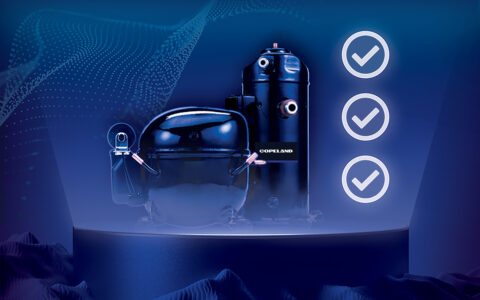Address efficiency mandates with compression technologies

Strategies for complying with DOE and ENERGY STAR® in self-contained and remote condensing units
As the industry awaits the Department of Energy’s (DOE) next energy conservation rulemaking in self-contained equipment and remote condensing refrigeration systems — likely to occur in 2026 — many original equipment manufacturers (OEMs) are preparing to initiate their next design cycles. For OEMs also seeking to achieve the highest standards of energy efficiency via ENERGY STAR certification, this redesign process is likely well underway.
Many commercial refrigeration equipment OEMs have already implemented a variety of design enhancements to meet previous energy efficiency requirements. As a result, they may have relatively few options remaining to achieve the DOE’s next efficiency standard. Measurable improvements will require upgrades to existing components — specifically via advancements in compression technologies.
OEMs are also initiating new equipment design cycles to meet energy efficiency standards using lower-global warming potential (GWP) refrigerants. These efforts are being driven by the finalization of the Environmental Protection Agency’s (EPA) Technology Transitions rule, which established GWP limits on new self-contained and remote equipment that will take effect over the next few years.
Solving two challenges at once
Copeland is helping commercial refrigeration equipment OEMs to complete design changes that comply with both DOE and EPA mandates by developing energy-efficient, variable-speed compression technologies specifically designed to maximize energy efficiencies while leveraging emerging lower-GWP refrigerants. These low-profile solutions are comprised of two components:
- Copeland variable-speed compressor — low-profile models are available in ranges from ½ to 5 horsepower (HP); featuring a brushless permanent magnet (BPM) motor vs. a standard induction motor
- Variable-speed drive with a smart controller — includes serial, frequency and drop-in modes; drop-in mode serves as the system controller
The breadth of the Copeland variable-speed compressor line gives system design engineers a variety of compressor options with which to achieve significant energy reductions in varying types and sizes of commercial refrigeration equipment — from self-contained equipment to remote condensing units and/or systems. Per Copeland’s internal testing, variable-speed capabilities — combined with smart controls — deliver energy and performance improvements that far exceed fixed-capacity options, including:
- Typical system energy savings of 15-20%, but in many cases much more (compared to fixed-speed, R‑290 systems)
- Reduced compressor cycling by 90 percent
- Lowered compression ratios by 43 percent
- Faster pull-downs to setpoint temperatures
- More precise temperature holding
- Less wear and tear on system components
- Lower energy bills
For OEM customers, variable speed systems helps maximize the capacity of any given refrigerant charge, compensating for losses that can occur when moving to low-GWP alternatives such as R-290 or R-454C. They also offer increased reliability and greatly improved system performance in terms of efficiency, audible noise, and precision.
By utilizing next-generation refrigerants, OEMs can offer systems that meet some of the most stringent energy efficiency and refrigerant regulations to date, including:
- Impending DOE 2026 standard
- California Air Resources Board (CARB) mandates
- ENERGY STAR certification
- EPA Technology Transition rule
Although the refrigerant transition adds potential complexity to OEM design cycles, it may contribute to improving energy efficiencies. Leveraging the energy efficiency and performance advantages of variable- versus fixed-speed compression technology is also an effective equipment design strategy.
High efficiency meets low profile
To accommodate the full range of commercial refrigeration equipment types and sizes, Copeland leads the industry in the development of low-profile, higher-capacity fractional and smaller-horsepower scroll and hermetic compressors. Available in both fixed- and variable-speed options, these robust compression solutions deliver high performance and energy efficiency in small sizes and fractional HP ranges.
Copeland hermetic compressors
Copeland hermetic compressor models are ideal for many smaller, medium-temperature (MT) and low-temperature (LT), reach-in units and display cases.
Current refrigerant options for hermetic compressors include A1 (R-448 and R-449A) and R-290. Copeland is in the process of optimizing these compressors for use with A2L refrigerants; samples are available on request.
Low-profile scroll compressors (fixed- and variable-speed)
Low-profile Copeland scroll compressors are engineered to help OEMs overcome design limitations and achieve energy efficiency mandates while supporting their customers’ sustainability and merchandising goals. Available in fixed- and variable-speed models, Copeland horizontal and vertical scroll compressors deliver industry-leading reliability, efficiency and low noise levels.
Copeland variable-speed scroll compressors are approved for use with A1 and R-290 refrigerants; they are currently being optimized for use with A2L refrigerants and higher charges of R-290. A2L-optimized models will be released this year, with samples now available on request.
Commitment to compliance
Transitioning to lower-GWP refrigerants while achieving new efficiency standards — all within a compressed timeline — only introduces degrees of complexity to the design cycle equation. But as the industry has demonstrated with previous rulemaking cycles, those goals are achievable.
To learn more about how Copeland can help you meet the next round of DOE efficiency standards or achieve ENERGY STAR certification, read the full version of the article.

8 proven strategies for rigorous cold chain management
by Dan Knauer | Cold Chain
Preparing for the approval and safe use of A2Ls in commercial refrigeration applications...
Protection for high-value shipments just got even better
by Alex Axelsson | Cold Chain, Transportation
We’re excited to announce the release of Copeland’s newest real-time tracker, the GO Real-Time...

Three proven strategies to prevent cargo theft
by Chris Lafferty | Cold Chain, Transportation
The over-the-road (OTR) transport industry is experiencing a surge in cargo thefts. As thieves...
The post Address Efficiency Mandates with Compression Technologies appeared first on Copeland.